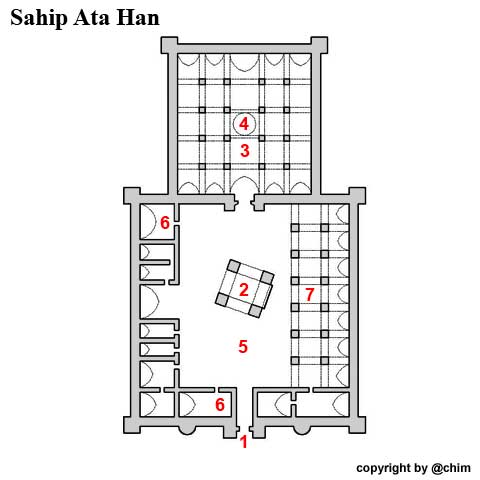 |
| Sahip Ata Han | ||||||||||||||
|
|
|
|||||||||||||
| The Portal | ||||||||||||||
|
Sahipata Han (also Sahip Ata Han) is a Seljuk caravanserai. It is located in today's place Sultandağı at the D300 between Afyonkarahisar and Akşehir. |
||||||||||||||
|
|
||||||||||||||
| The Portal | ||||||||||||||
|
ccording to the inscription plate, the Sahipata Han was built in the years 1249-1250 under Sultan Izzeddin Keykavus II. Sahip Ata Fahrettin Ali was also known as Fakhr al-Din Ali († 1288/1289), a Seljuk politician. He was vizier and grand vizier in the Sultanate of Rum-Seldschuken. Under his patronage the Han was established. |
||||||||||||||
|
|
||||||||||||||
| The south side at the closed hall | ||||||||||||||
|
On 3 February 2002, an earthquake of magnitude 6.0 shook the region. The epicentre was near the city of Bolvadin with its 40,000 inhabitants. The hardest hit was Sultandağı : Here alone, more than a dozen inhabitants lost their lives as a large part of the city centre was destroyed. The Han was badly damaged, the mosque in the inner courtyard almost completely collapsed. In 2005, the Selcuk University in Konya began extensive restoration work. The work was completed in 2008 and completed in 2009. The main focus was on the mosque. |
||||||||||||||
|
|
||||||||||||||
| The mosque towers above the outer walls | ||||||||||||||
|
|
||||||||||||||
| The north side | ||||||||||||||
|
|
||||||||||||||
|
The vault and dome had already been repaired in the 19th century. In 1970 the roof of the closed hall was repaired. Unfortunately, unsuitable materials were used which already absorbed moisture during the restoration work and contributed to the collapse during the earthquake in 2002. The northeast facing front of the Sahipata Han with the entrance portal is parallel to the street. It was built in the Seljuk tradition with a closed hall (also called winter hall) and a converted inner courtyard. A peculiarity of the mosque: It is twisted by 20° around its axis traditionally to the north. The inscription plates above the outer and inner portal have been preserved. With the mosque in the inner courtyard, the Sahpata Han joins the line of caravanserais such as the Ağzikara Han and the Sultan Han, both near Aksaray. Dimensions: Closed hall: 26 x 26 m, inner courtyard: 36 x 38 m = total 2044 sqm, mosque: 7 x 7 m |
||||||||||||||
|
|
||||||||||||||
|
|
||||||||||||||
| The east side | ||||||||||||||
|
|
||||||||||||||
|
In the west wall of the mosque sarcophagus fragments from Roman and Byzantine times came to light during the renovation work. Little is known about the history of the settlement. Just like the town of Akroinos or Akroinon, as Afyonkarahisar was called in Roman and Byzantine times, which is more than 70 km away. It is proven that the Byzantine emperor Leo III successfully defended the city against the Arabs in the battle of Akroinon in 740. The battles are said to have stretched far to the east. |
||||||||||||||
|
|
||||||||||||||
|
|
||||||||||||||
|
The Bathhouse |
||||||||||||||
|
|
||||||||||||||
|
A rarity, which one finds only with few Han, like e.g. with the Kargi Han and with the Ağzikara Han, is a separate bath house outside the Han. Although the original date of construction has not been preserved, the characteristic features of the building suggest that it was built during the Seljuk period. In the course of time the building was renovated several times. After considerable damage at the beginning of the eighties of the last century, the bath was again extensively restored and is still in use today as a municipal bath, "Şehır Hamamı". |
||||||||||||||
|
|
||||||||||||||
|
||||||||||||||
| Photos: @chim, Monika P. | ||||||||||||||
| Translation aid: www.DeepL.com/Translator | ||||||||||||||
| Source: Wikipedia and others | ||||||||||||||
|
|
||||||||||||||


